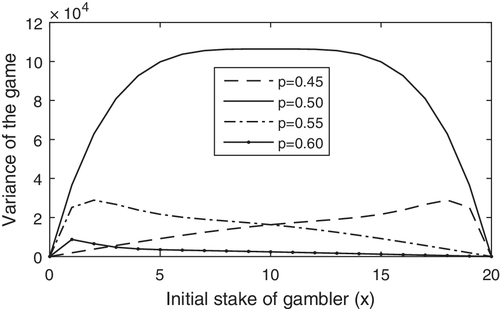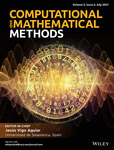The classic two-player gambler's ruin problem with successive events: A generalized variance
Abstract
In this article, we present the general expressions for the variance of the ruin time of the classic two-player gambler's ruin problem with successive and nonoverlapping trials. The rationale of this game plan is motivated by its exhibition in the game of tennis, where a player is required to win two consecutive serves to win the point after achieving deuce. This strategy (i.e., decision is based on successive and nonoverlapping trials) is in favor of the player, who plays with a better skill set and reduces the chances of decision based only on luck. We explicitly derive the general expressions of variance up to m successive and non-overlapping trials for the case of symmetric and asymmetric games. It is proved that the expressions given in literature for the symmetric and asymmetric cases are the sub cases of our proposed expressions. Finally, some special games (i.e., m = 2) are simulated and the results are verified with the proposed formulas.
1 INTRODUCTION
In classic version of the ruin problem, two players initiate with x and t − x stakes, say dollars, involved in the game. Here, x is the initial stake of the gambler and t denotes the total stake involved in the game. After a trial, the gambler wins with probability p and losses with probability q, where p + q = 1. This problem was, probably, first posed by Pascal, see for example, Reference 1 for a historical background. Since then, a variety of associated questions, game modifications, and extensions have been considered in the literature. For example, for the expressions of ruin probability and ruin time of the game, see Reference 2. Further, the conditional expectations of the ruin time of game, were investigated in References 3-5. Where, Reference 6 proposed the use of tie event and thus insisted on more realistic version of the classic problem. More recently, in adjacent past Reference 7, yet introduced another variant of the classic ruin problem by involving occurrence of successive events in the decision-making process.
In upcoming Section 2, we present the mathematical structures obtaining the variance expressions under Reference 7 proposed strategy of successive events. In next section (Section 3), we evaluate the validity of mathematical findings of Section 2, both numerically and through simulation-based investigation. Finally, we summarize our research in Section 4.
2 MATHEMATICAL DERIVATIONS
Therefore, we are required to find the solutions for the difference equations (4) and (5). The objectives are attained through the method of undetermined coefficients. In the upcoming subsections, we treat the symmetric case, that is, p = q = 1/2 and asymmetric case, where p ≠ q, separately.
2.1 The variance for the case of symmetry
It remains verifiable, that for m = 1, the above expression reduces to Reference 9, given in Equation (1).
2.2 The variance for the case of asymmetry
After an other iteration of L. Hospital rule, we obtained . One may notice that, for q = 1/2, the resultant Dx remains similar to that of Equation (6).
3 PERFORMANCE EVALUATION
3.1 Numerical results
Table 1 presents the values of v(T), for both symmetric and asymmetric games. The variance behavior is then quantified under various parametric settings while fixing the more practical and feasible value of nonoverlapping and successive events, that is, m = 2. Moreover, for the demonstration purposes we considered, t = 20 and x = 5, 10, and 15. For the case of symmetric game, we notice that the variance gains its maximum value at x∗ = t/2 = 10, where x∗ ∈ (0, t). For the asymmetric game, the above settings are further studied for the variant value of winning probabilities of the gambler, such as p = 0.20 to p = 0.90. It is observable that the x∗ depends only, on the total fortune in game, that is, t and on the ratio q2/p2. Further exploration of the particular setting indicates that the function v(T) has a maxima attained at point x∗, such that x∗ ∈ (0, t/2) if q < p and x∗ ∈ (t/2, t) if q > p. For visual demonstration purposes, the graphs of v(T) are depicted in Figure 1, as functions of continuous variable of initial dollar, that is, x. Display behaviors of variability with respect to winning probability and initial stake, stay consistent with the theoretical and mathematical orientation of the strategy.

| p | x | y = t − x | v(T) | Simulations | ||||||||||||||||||||||||
|---|---|---|---|---|---|---|---|---|---|---|---|---|---|---|---|---|---|---|---|---|---|---|---|---|---|---|---|---|
| 5 | 15 | 29.63 | 29.1036 | |||||||||||||||||||||||||
| 0.20 | 10 | 10 | 59.26 | 59.0589 | ||||||||||||||||||||||||
| 15 | 5 | 88.89 | 90.3146 | |||||||||||||||||||||||||
| 5 | 15 | 60.00 | 58.5949 | |||||||||||||||||||||||||
| 0.25 | 10 | 10 | 120.00 | 118.9178 | ||||||||||||||||||||||||
| 15 | 5 | 180.00 | 179.4343 | |||||||||||||||||||||||||
| 5 | 15 | 131.25 | 131.7653 | |||||||||||||||||||||||||
| 0.30 | 10 | 10 | 262.50 | 264.3643 | ||||||||||||||||||||||||
| 15 | 5 | 393.64 | 392.4603 | |||||||||||||||||||||||||
| 5 | 15 | 9194.71 | 9136.837 | |||||||||||||||||||||||||
| 0.45 | 10 | 10 | 16,307.35 | 16,273.20 | ||||||||||||||||||||||||
| 15 | 5 | 21,637.20 | 22,052.30 | |||||||||||||||||||||||||
| 5 | 15 | 99800 | 100,254.50 | |||||||||||||||||||||||||
| 0.50 | 10 | 10 | 106,400 | 106,486.50 | ||||||||||||||||||||||||
| 15 | 5 | 99,800 | 100,131.44 | |||||||||||||||||||||||||
| 5 | 15 | 3504.74 | 3533.9530 | |||||||||||||||||||||||||
| 0.60 | 10 | 10 | 2386.56 | 2383.4180 | ||||||||||||||||||||||||
| 15 | 5 | 1199.57 | 1204.4470 | |||||||||||||||||||||||||
| 5 | 15 | 1008.27 | 1009.3200 | |||||||||||||||||||||||||
| 0.65 | 10 | 10 | 673.99 | 665.8152 | ||||||||||||||||||||||||
| 15 | 5 | 337.04 | 336.8547 | |||||||||||||||||||||||||
| 5 | 15 | 44.61 | 44.8808 | |||||||||||||||||||||||||
| 0.85 | 10 | 10 | 29.74 | 29.6462 | ||||||||||||||||||||||||
| 15 | 5 | 14.87 | 15.1053 | |||||||||||||||||||||||||
| 5 | 15 | 21.09 | 21.0858 | |||||||||||||||||||||||||
| 0.90 | 10 | 10 | 14.06 | 14.1915 | ||||||||||||||||||||||||
| 15 | 5 | 7.03 | 7.1249 |
3.2 Simulation study
In this subsection, we validate the numerical findings of the Section 3.1, through a rigorous simulation study. The games involving m = 2 are simulated with MATLAB (version R2015a). The reported results are based on 50,000 execution of games, for symmetric and asymmetric cases. A vividly close match between numerical results and simulated findings remains motivational.
4 SUMMARY AND FUTURE WORK
In this paper, we provided the expressions of the variance of the classic two-player ruin's problem based on successive events. The mathematical results are established for both, symmetric and asymmetric games, involving even and odd dollars as total stake in the game. This research extends the existing ruin problem literature for a novel strategy minimizing the extent of indecisiveness in the game and weighing the skill set of players, heavily. In future, it is attractive to investigate the variability structure for the game involving three players.
ACKNOWLEDGEMENTS
The authors are very grateful to the chief-in-editor and referees for their valuable suggestions that have made this article worthy to be published.
CONFLICTS OF INTEREST
No conflict of interest is reported by authors.
Biographies

Dr. Abid Hussain obtained his PhD (Statistics) degree in 2018 from Quaid-i-Azam University, Islamabad, Pakistan. His focused research areas of interest are Applied Probability, Stochastic Processes, Operations Research and Nonparametric Statistics.

Dr. Salman A.Cheema obtained his PhD Statistics degree from The University of Newcastle, Australia and MS Statistics degree from Virginia Tech, USA. His focused research areas include Data masking, Optimization, Choice Models and Social desirability bias.




